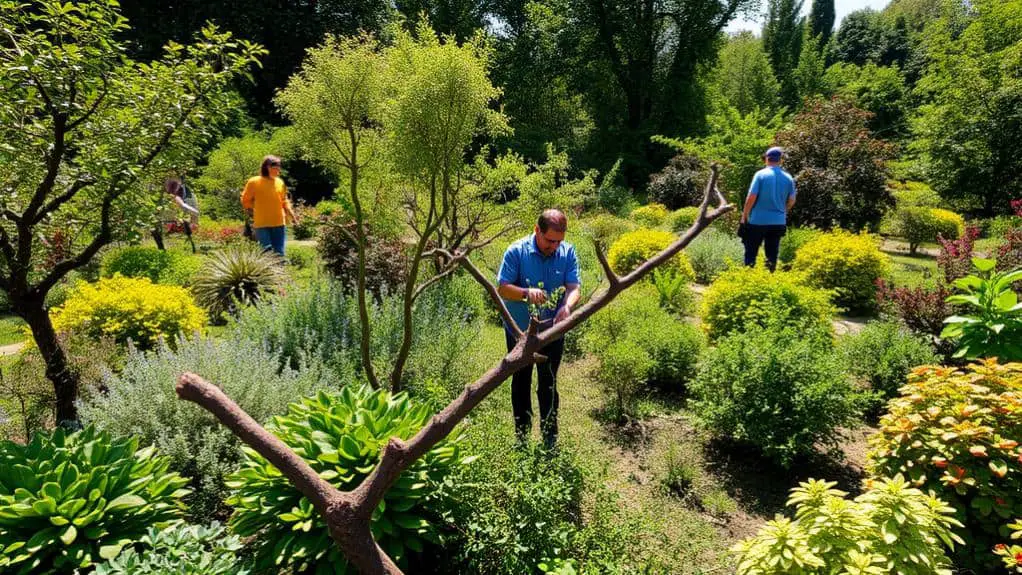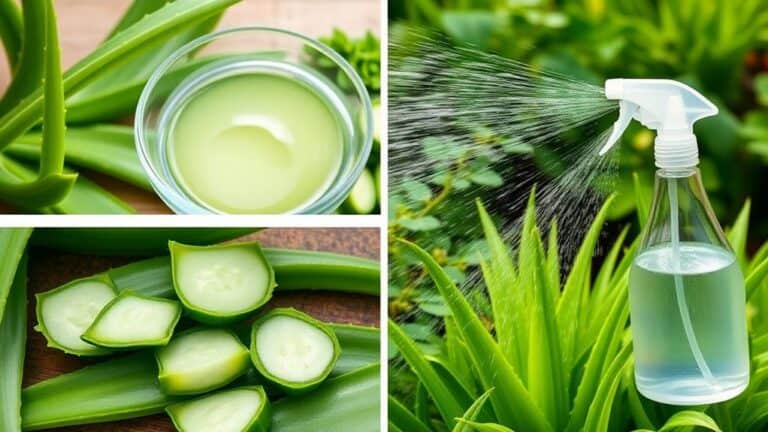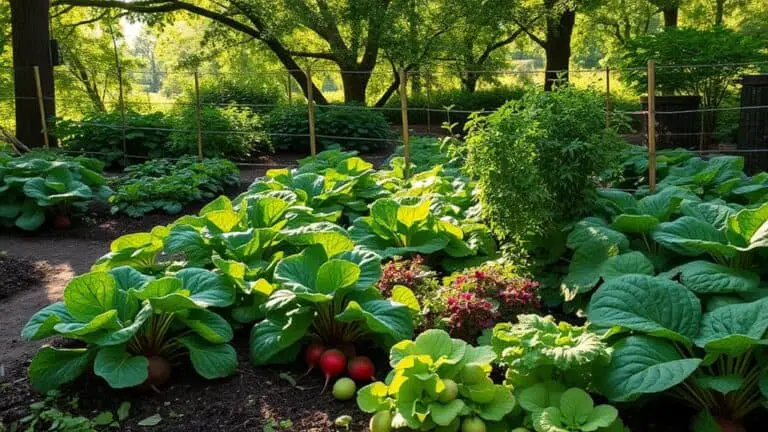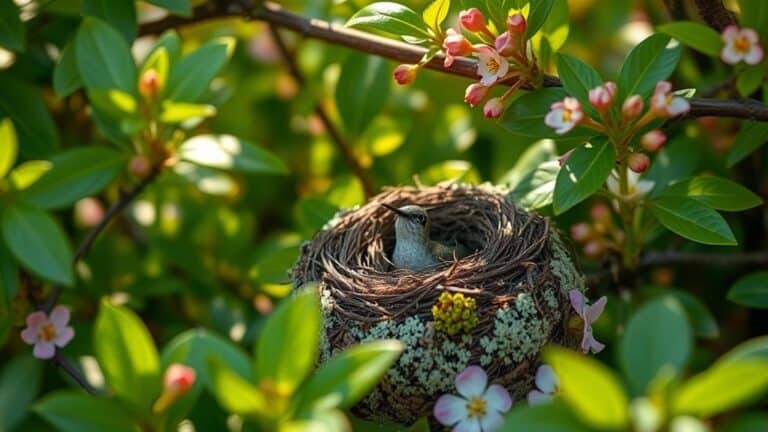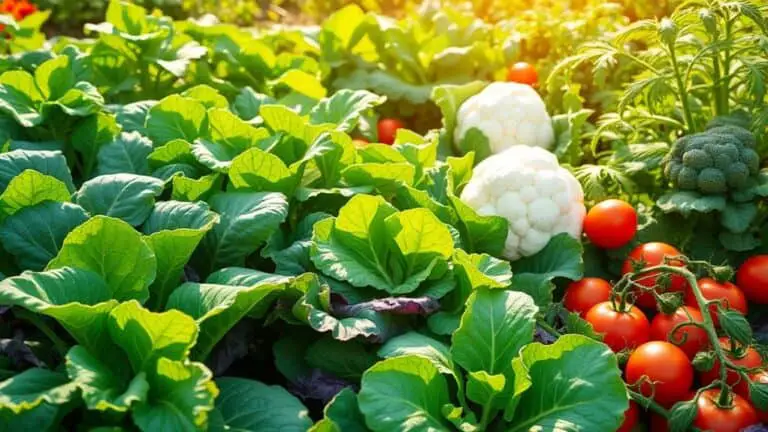Plants And Trees That Need A Summer Pruning
When it comes to maintaining a lush and productive garden, summer pruning stands out as a vital practice for several types of plants and trees. I've found that spring-flowering shrubs, tender shrubs, and fruit trees all benefit from timely trims, encouraging better air circulation and light penetration. Plus, climbers and rambling roses experience a boost in flowering with proper pruning. Even evergreens need a light touch to keep their structure intact and fend off diseases. Curious about the best techniques or the essential tools for the job? Let's explore how to make the most of summer pruning.
Importance of Summer Pruning
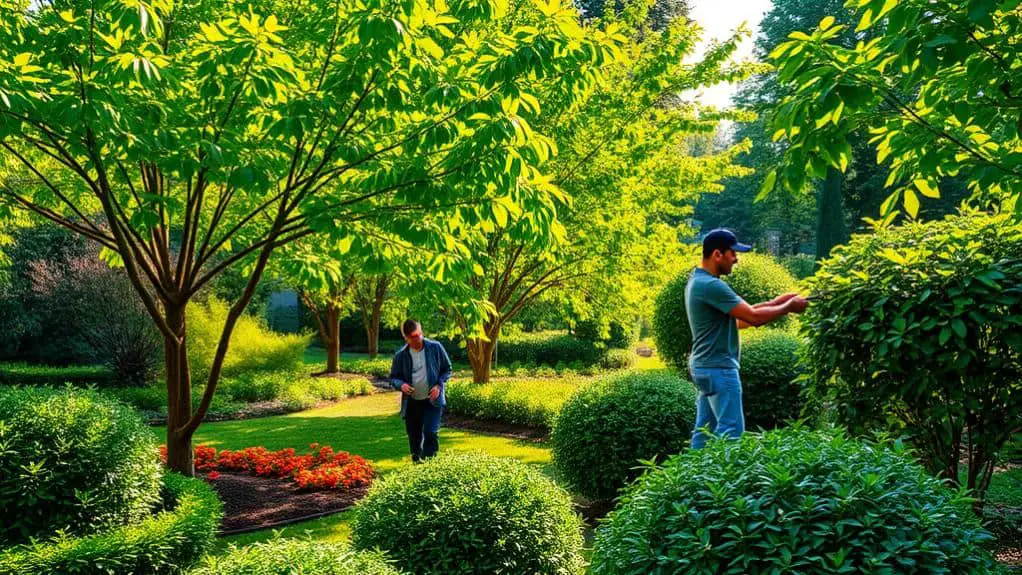
Summer pruning is essential for maintaining the health and vigor of your plants and trees. By pruning in late spring to early summer, you allow better air circulation and light penetration, which reduces the risk of disease and pests.
When it comes to fruit trees, summer pruning encourages the accumulation of potassium, leading to increased flowering and fruit production. It also helps keep your plants the desired shape and size, enhancing the overall beauty of your garden.
Removing dead or diseased branches during this time promotes stronger new growth, ensuring your plants remain robust. Regular summer pruning allows you to manage the growth of your plants effectively, making your garden not only healthier but also more aesthetically pleasing.
Spring-Flowering Shrubs
Have you ever wondered how to keep your spring-flowering shrubs looking their best?
Summer pruning is the key! Once shrubs like Deutzia, flowering quince, Forsythia, lilac, and Philadelphus finish blooming, it's time to prune. Early summer, after the frost risk passes, is perfect. This promotes new growth and maintains their shape.
Grab your loppers for thicker branches and pruning shears for delicate cuts. Remove frost-killed stems and any dead or diseased wood.
This not only rejuvenates the plant but also improves air circulation within the shrub, reducing disease risk.
Tender Shrubs
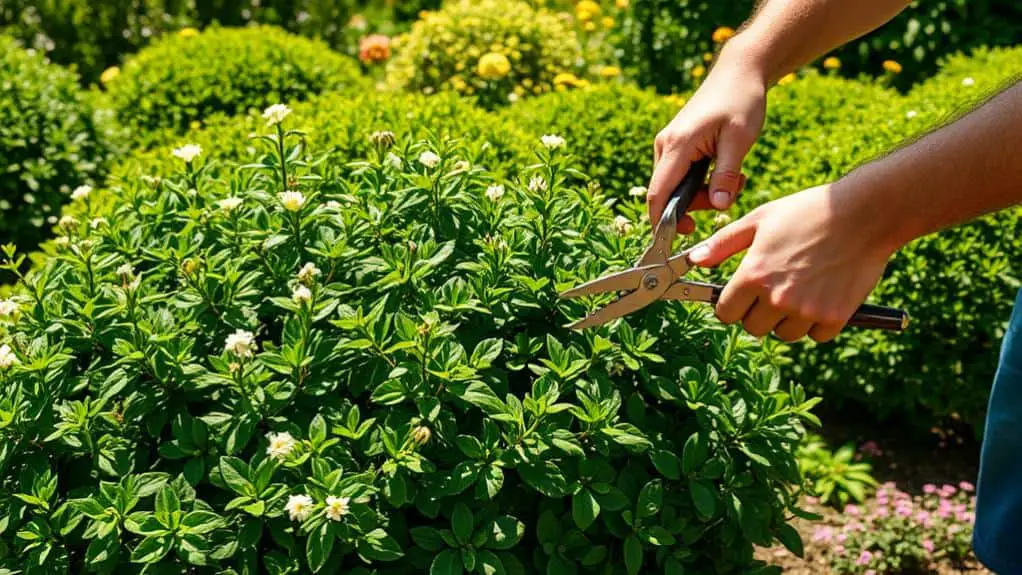
Maintaining healthy tender shrubs like Abutilon, outdoor fuchsias, Hibiscus sinosyriacus, and Romneya involves strategic summer pruning.
To encourage robust new growth, it's crucial to prune these plants after they finish blooming. Here's how I do it:
- Use secateurs: Focus on removing the oldest, woody stems down to the base to rejuvenate the plant.
- For thicker branches: A pruning saw might be needed to guarantee clean cuts and minimize damage.
- Timing: Prune right after the blooming period to promote enhanced flowering next cycle.
Regular summer pruning of tender shrubs improves their vigor and aesthetic appeal, guaranteeing a healthy and attractive landscape.
Fruit Trees
Let's talk about summer pruning for your fruit trees, like apples, cherries, pears, and plums.
By removing soft new growth, you help sunlight and air reach the fruit, which makes it taste better and grow bigger.
Plus, pruning in late spring to early summer after the frost keeps your trees healthy and strong, reducing the risk of diseases.
Enhanced Fruit Production
Pruning your fruit trees in the summer is essential for boosting fruit production and improving the overall quality of your harvest.
Summer is a good time to thin out crowded branches, allowing the tree to focus on fruit formation rather than unnecessary growth. This practice helps the tree allocate energy more efficiently, leading to larger and healthier fruits.
Here are three key benefits:
- Improved Light and Air Circulation: Removing soft new growth enhances light and air penetration, benefiting fruit ripening.
- Higher Potassium Levels: Summer pruning encourages potassium accumulation, vital for flowering and fruiting potential.
- Manageable Tree Size: Regular pruning maintains your tree's shape and size, making it easier to harvest and care for.
Disease Prevention Techniques
When it comes to keeping your fruit trees healthy, summer pruning offers a powerful method for disease prevention. By removing dead, diseased, or damaged branches, you reduce the risk of disease spread and improve airflow within the canopy.
Thinning out crowded areas allows more light to penetrate, helping fruits ripen and preventing fungal diseases. Regular pruning encourages new, healthy shoots, which are less susceptible to disease.
Remember to disinfect your pruning tools between cuts to avoid spreading pathogens like fire blight. Also, removing suckers and water sprouts reduces plant stress and vulnerability to diseases.
Be careful not to prune too early, as this can harm the tree and increase disease risk. Happy pruning!
Climbers

Now, let's talk about climbers like Wisteria, Jasmine, and Honeysuckle, which really benefit from summer pruning.
You should cut trailing stems back to 3-4 leaves on the current growth to keep them bushy and healthy.
Using secateurs, focus on removing thin, dead, or diseased stems, especially on rambling roses, to boost air circulation and keep diseases at bay.
Essential Pruning Tools
For those of us tending to climbers like Wisteria and Honeysuckle, having the right pruning tools is essential. Pruning plants in summer keeps them healthy and vibrant.
To achieve this, I recommend the following tools:
- Secateurs: Perfect for precise cuts on delicate stems, essential for tidying up trailing growth.
- Pruning Saw: Necessary for tackling thicker, older branches without causing damage.
- Gloves: Protect your hands from thorns and rough branches while pruning.
Regular pruning helps reduce tangling, ensuring better light exposure and airflow. Aim to prune trailing stems to about 3-4 leaves on current growth, promoting healthy flowering and maintaining shape.
Timing and Technique
Pruning climbers like Wisteria, Jasmine, and Honeysuckle is essential for managing their vigorous growth and ensuring a spectacular display of blooms. The best time to prune these climbers is right after their main flowering period ends. This way, you won't accidentally cut back potential flower buds.
When pruning, focus on cutting back trailing stems to 3-4 leaves on current growth. This helps maintain the plant's shape and promotes new blooms. Use secateurs for precise cuts, and always remove any thin, dead, or diseased stems.
Regular summer pruning prevents tangling and overcrowding, allowing better air circulation and light penetration. So, grab your tools and give those climbers the attention they need for a healthier, more vibrant garden!
Rambling Roses
As summer progresses, it's the perfect time to focus on maintaining our rambling roses, ensuring they flourish beautifully in the upcoming seasons.
Pruning is essential for healthy growth and vibrant blooms next year. Here are some steps to guide us:
- Remove Thin, Dead, or Diseased Stems: This allows for healthier growth and prevents disease spread.
- Cut Back Last Year's Growth: Doing this encourages new shoots and enhances the plant's overall vigor.
- Tie New Growth to Supports: This helps control the size, prevents tangling, and promotes even flowering.
Evergreen Trees

Let's talk about evergreen trees like pines and spruces, which can really benefit from some light trimming during the summer.
By snipping away dead or damaged branches and thinning out crowded areas, we can improve air circulation and reduce the risk of diseases.
Remember to make cuts just above a bud or lateral branch to encourage new growth, and always use clean, sharp tools to keep your trees healthy.
Light Trimming Tips
When it comes to keeping your evergreen trees healthy and looking their best, light trimming is crucial. This practice encourages healthy growth without stressing the plant.
Here are a few tips to get you started:
- Timing: Perform light trimming from late spring to early summer. This period is ideal for maintaining shape and promoting growth.
- Technique: Focus on removing dead or damaged branches first. Use sharp pruning shears or loppers to make clean cuts just above a bud or internode.
- Moderation: Avoid excessive trimming. Over-pruning can reduce foliage, impacting the tree's overall health. Regular light trimming helps manage size and prevents overcrowding.
Following these tips guarantees your evergreens stay vibrant and lush all season long!
Air Circulation Importance
Beyond light trimming, ensuring proper air circulation within your evergreen trees is essential. Early summer is the perfect time to prune because it helps reduce the risk of fungal diseases by thinning out excess foliage. This allows sunlight to penetrate deeper into the tree, promoting healthier growth.
By improving air circulation, you can lower humidity around the leaves, preventing problems like needle cast and other pathogens.
Maintaining a balanced structure through pruning also helps your trees withstand strong winds and storms, reducing limb breakage. Plus, regular pruning keeps your evergreens looking their best, enhancing their shape and overall aesthetic appeal.
Pruning Techniques
Pruning techniques are essential for maintaining the health and aesthetics of your plants and trees. When I prune, I always aim to preserve the natural growth of my plants.
Here are three key tips:
- Proper Cuts: Make cuts above a bud or internode, sloping downward. This helps water runoff and prevents rot.
- Healing: Avoid cutting too close to buds and leave a small collar. This helps the plant heal more effectively.
- Large Limbs: When dealing with larger limbs, under-cutting before the final cut prevents tearing and bark damage.
Also, always make clean cuts outside the callous bark collar to reduce infection risk and promote faster healing.
Don't forget to disinfect your tools between cuts to prevent spreading diseases.
Essential Pruning Tools
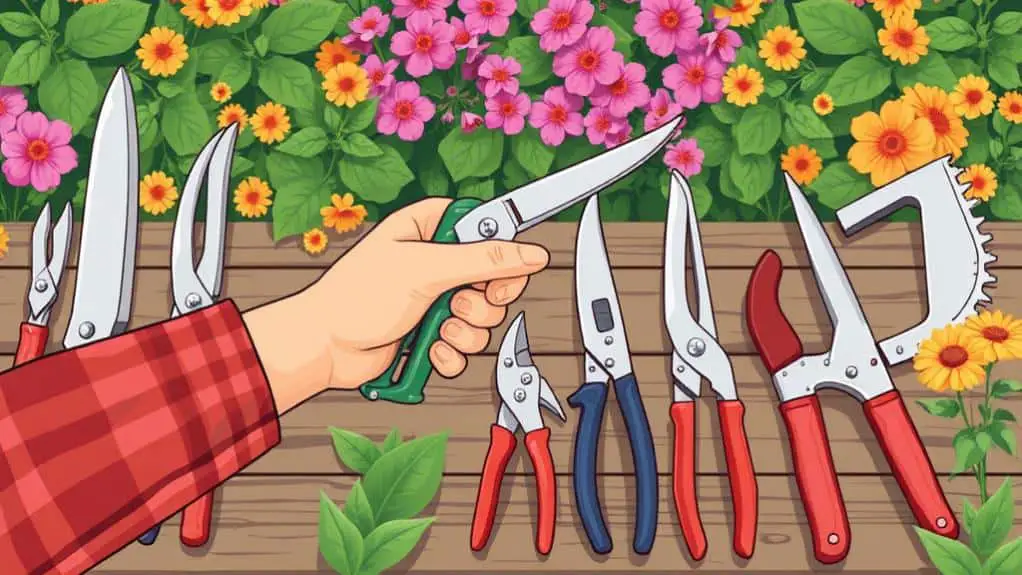
Having mastered the techniques for effective pruning, it's time to equip ourselves with the right tools. Sharp pruning shears are vital for making clean cuts on small branches and delicate stems, which helps minimize plant damage. For thicker branches, loppers provide the necessary leverage and reach. When dealing with larger limbs, a hand saw guarantees a clean cut that promotes healing. A pruning knife is perfect for delicate work like shaping or making precise cuts in small plants and flowers. Safety goggles and gloves are important to protect yourself from injuries. Here's a quick guide to evoke some excitement about our essential tools:
| Tool | Use Case | Benefit |
|---|---|---|
| Pruning Shears | Small branches, delicate stems | Clean cuts, minimal plant damage |
| Loppers | Thicker branches | Leverage, effective pruning |
| Hand Saw | Larger limbs | Clean cuts, promotes healing |
| Pruning Knife | Delicate work | Precision cuts, ideal for shaping |
Common Pruning Mistakes
When it comes to maintaining the health and aesthetic of your garden, knowing the common pruning mistakes is essential.
Let me share a few key pitfalls to avoid:
- Pruning too late: Cutting back your plants too late in the season can expose them to frost damage, which hampers their ability to recover and grow.
- Using dull tools: Jagged cuts from dull or inappropriate tools increase the risk of disease and pests, compromising plant health.
- Over-pruning: Taking off too many leaves stresses the plant, reducing its ability to photosynthesize and produce food.
Frequently Asked Questions
What Trees Can You Prune in Summer?
For the best tree health, I recommend using proper pruning techniques on trees like apples, cherries, pears, plums, maples, walnuts, and birches in summer. Be cautious with oaks and elms due to disease risks.
What Is the Best Time for Summer Pruning?
I find the best time for summer pruning is in July. Using proper pruning techniques then promotes tree health by managing growth after spring and removing energy-draining suckers, ensuring your trees thrive without the stress of extreme heat.
Why Not to Cut Trees in Summer?
I don't recommend cutting trees in summer because it can harm tree health. Improper pruning techniques can invite diseases, pests, and stress the tree, leading to reduced food production and poor growth in the following year.
Which Fruit Trees Need Summer Pruning?
When it comes to summer pruning, I focus on my apple tree and peach tree. Pruning helps improve fruit quality and size by removing suckers and water sprouts, allowing better light and air circulation. It's essential for healthy growth.
Conclusion
So, there you have it! Summer pruning isn't just a chore; it's a fantastic way to keep your plants healthy and thriving. From spring-flowering shrubs to fruit trees and climbers, a little trim can do wonders. With the right tools and techniques, you can make your garden the envy of the neighborhood. Just remember, the key is to prune smartly and avoid common mistakes. Happy gardening, and let's make those plants look their best!

